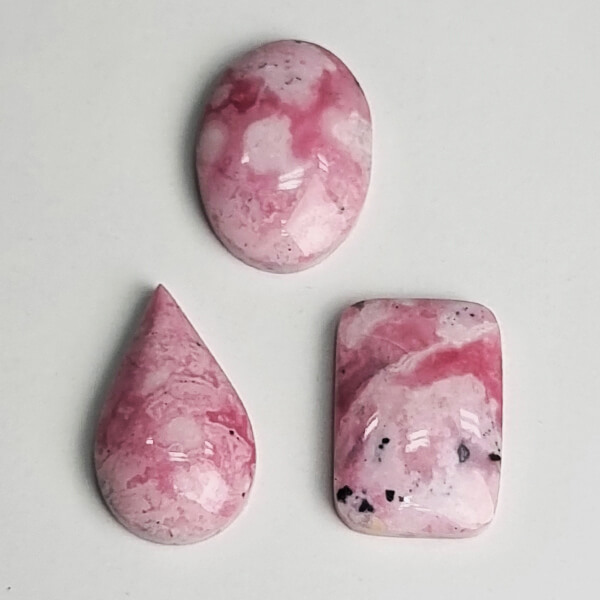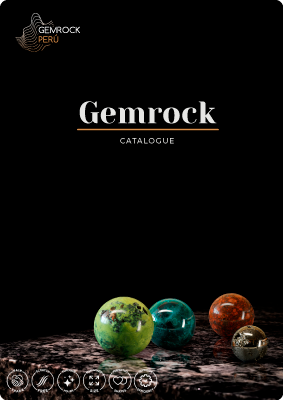Rhodonite
Gemstone Quality Standard

About Rhodonite
Rhodonite is a manganese silicate mineral with an opaque transparency. Rhodonite comes in shades that vary from pale pink to deep red. It has a vitreous luster and is composed of other minerals such as calcite, iron, and magnesium.
It commonly occurs as cleavable to compact masses with a rose-red color, often tending to brown because of surface oxidation. The name comes from the Greek ῥόδος rhodos, rosy.


Rarity
We don´t know how big the natural reserve of Rhodonite is in Peru.
Availability
Rhodonite is readily available in Peru. We sell rough rock, preselected jewelry-grade slabs, decor products, cabochons, and our own jewelry with Rhodonite.
You can buy our finished top-quality cabochons for jewelry makers.
National and international shipping from our US-based warehouse.



Color
Rhodonite comes in shades that vary from pale pink to deep red.
Impurities
Black and brown Manganese Oxides




Jewelry-grade material
Jewelry-grade material should show no or very little black oxide impurities. When selecting our material we are discarding 90% of rough rock as unsuitable for jewelry.
Polishable
Rhodonite can be polished to a glass-finish.
Cutting Quality
Advantages:
Rhodonite does not tend to break or chip. Experienced cutters therefore can obtain very sharp unchipped edges between the backside and bezel as well as between the bezel and dome.
Top-cutting-quality is characterized by:
- a polished backside
- a sharp unchipped edge between the backside and the bezel
- a very straight and even highly polished bezel
- a sharp unchipped edge between the bezel and the dome
- a well-shaped dome, not showing any deformation
- Top-quality polish


Be aware of wrongful material grading
It’s commonplace in the crystal industry to cut cheap cabochons from any kind of Rhodonite without applying any kind of grading for high-quality material. nearly all of the cabochons that we found on offer on the internet were made from material that we would consider unsuitable for jewelry, with terrible brownish red colors, full of brown, white, and black oxide impurities. Unscrupulous dealers take advantage of the lack of knowledge of crystal shops, jewelers, and final clients and market such low-grade and even trashy material as top-grade material.






Be aware of low-quality cutting
The global cabochon market is flooded with low-quality cabochons. Lower and lower prices lead to cutters working faster and with less care which leads to decreasing quality in terms of shapes and polish. At the same time, cutters are not well trained and cut with substandard technology. Cheap cabochons have rounded-off edges not showing quality bezels anymore and there are so many of those rounded-off cabs on the market that most buyers don’t even know anymore what a bezel is. Following we are showing two examples of bad quality cutting.

The light reflection in the cab surface shows that the dome of the cab is not formed well. The center area of the cab is flattened out while the border has a steeper curve. This leads to an angle in the dome that runs parallel to the border of the cab and is made obvious by the light reflection.

This example is worse than the previous one. The light reflection shows a terribly unequal dome. Additionally, the borders of the cab are not even well cut and show irregularities and holes. Finally, the light reflection on the surface is not crispy but rather diffuse, indicating that the surface polish is very low quality.


Pricing
Adequate pricing must take into account the cost factors to obtain top-quality cabochons:
- Acquisition of top-grade Rhodonite with strong color in the mine.
- Selection of material without impurities and discarding more than 90 percent of the rough rock as unsuitable for jewelry.
- A usual material loss of approximately 90 % of the selected material during the cutting and shaping process.
- The level of experience required by a cutter to produce a flawlessly shaped and highly polished cabochon.
You can buy our finished top-quality cabochons for jewelry makers.
National and international shipping from our US-based warehouse.
- Market research
- Our Jewelry Grade (A)
- Our Top-Quality Jewelry Grade (AA)
- Our Premium Jewelry Grade (AAA)
The data in this sheet has been compiled by reviewing a great number of websites and sales platforms.
Material quality:
Overall material quality is very low. Most cabochons are made from unsuitable material full of impurities or with ugly brownish and dull colors. We could not find any material quality grading standards and procedures that would justify the huge price differences that we can see on the internet.
Cutting quality:
The vast majority of “cabochons” on offer show very low cutting quality. Nearly all cabochons are cut with rounded corners (similar to a palmstone) which do not show any bezel. We estimate that no more than 10 % of the cabochons that are on offer show a decent level of cutting quality. In other words: 90% of offered cabochons would need to be graded below the Gemrock Jewelry Grade (A)
Quality Grading
Most cabochons were offered as AA or AAA quality, which obviously does not represent the reality. Given the fact that there is no commonly accepted grading standard AA and AAA gradings are used as a marketing strategy without reflecting a real criteria of quality. This type of marketing must be viewed as misleading.
Pricing
The average retail pricing for those low-quality cabochons is 0.60 USD per carat. Prices display a huge range from 0.21 USD per carat to a whopping 1.64 USD per carat, basically for the same low-quality material and bad cutting, without there being any realistic justification for such price differences. A higher price does not indicate a higher quality.
Jewelry-grade Material:
Pale rose-colored to dark rose-colored material. No brown impurities are allowed. Small dots of black manganese oxide impurities are tolerated.
Cutting Quality:
- Straight bezel (minor irregularities possible), 3 mm high
- Perfect dome (3-5 mm high)
- Edges between bezel and dome, as well as bezel and backside: sharp and crispy, minor chips on lower edge possible
- Backside flat at 280 grit, unpolished
Pricing:
Recommended Retail Price (A): 0.69 USD per carat
Top Jewelry-grade Material:
Pale rose-colored to dark rose-colored material. No brown or black impurities are allowed.
Cutting Quality:
- Straight bezel, 3 mm high
- Flat and perfect dome (3 mm high)
- Edges between bezel and dome, as well as bezel and backside: sharp and crispy, minor chips on lower edge possible but very rare.
- Backside flat, at 280 grit
Additional Quality (AA+): Backside polished to 3000 grit
Pricing:
Recommended Retail Price (AA): 0.99 USD per carat
AA+: 1.09 USD/c
Top Jewelry-grade Material:
Pale rose-colored to dark rose-colored material. No brown or black impurities are allowed.
Cutting Quality:
- Only cut by our best master cutters
- Straight bezel, 3 mm high
- Flat and perfect dome (1-3 mm high)
- Edges between bezel and dome, as well as bezel and backside: sharp and crispy, no chips on lower edge.
Additional Quality (AAA+): Backside polished to 3000 grit
Pricing:
Recommended Retail Price (AAA): 1.29 USD per carat
AAA+: USD/c

For Charms & Pendants
Ethical Silver Accessories
for Jewelry Makers
Hundreds of charms, pendants & chains
in
950 Silver, Sterling Silver, tarnish-resistant Moonlight Sterling Silver, gold-plated silver and gold.
Guaranteed Free of toxic alloys.
How to avoid fake & toxic silver:

For Chains

Cutting services
Do you need reliable high-quality cutting services for a reasonable price? Are you looking for a service provider that is willing to develop new products according to your requirements? Would you like to get expert advice in order to improve your product? Do you wish for someone to optimize the process and get the most out of your rough? Just talk to us.
Free Gemrock Learning Resources
Free Gemrock Learning Resources
Connect wherever you want and can
Connect wherever you want and can
Get in Touch
+51 994104206
gemrockinternational@gmail.com











